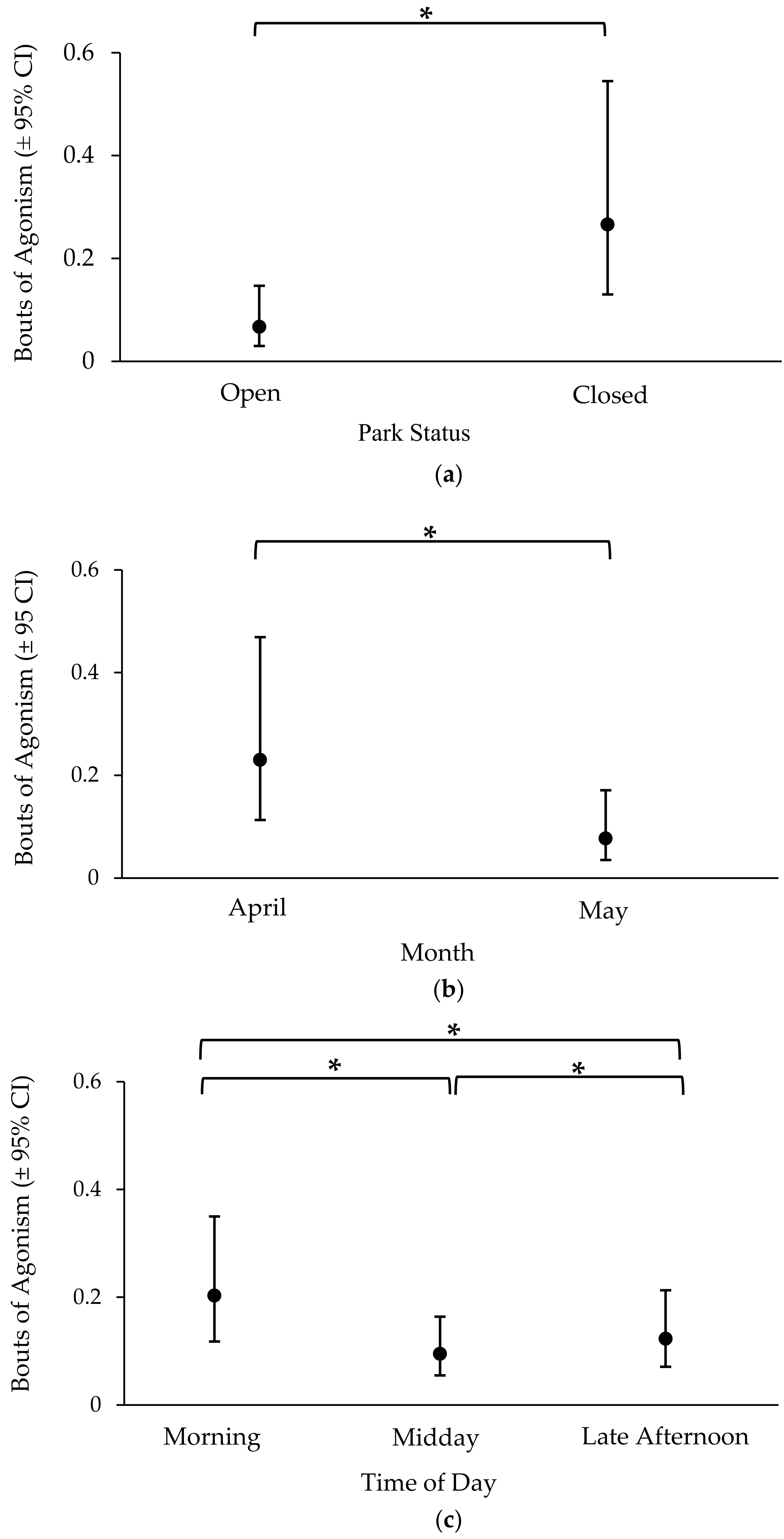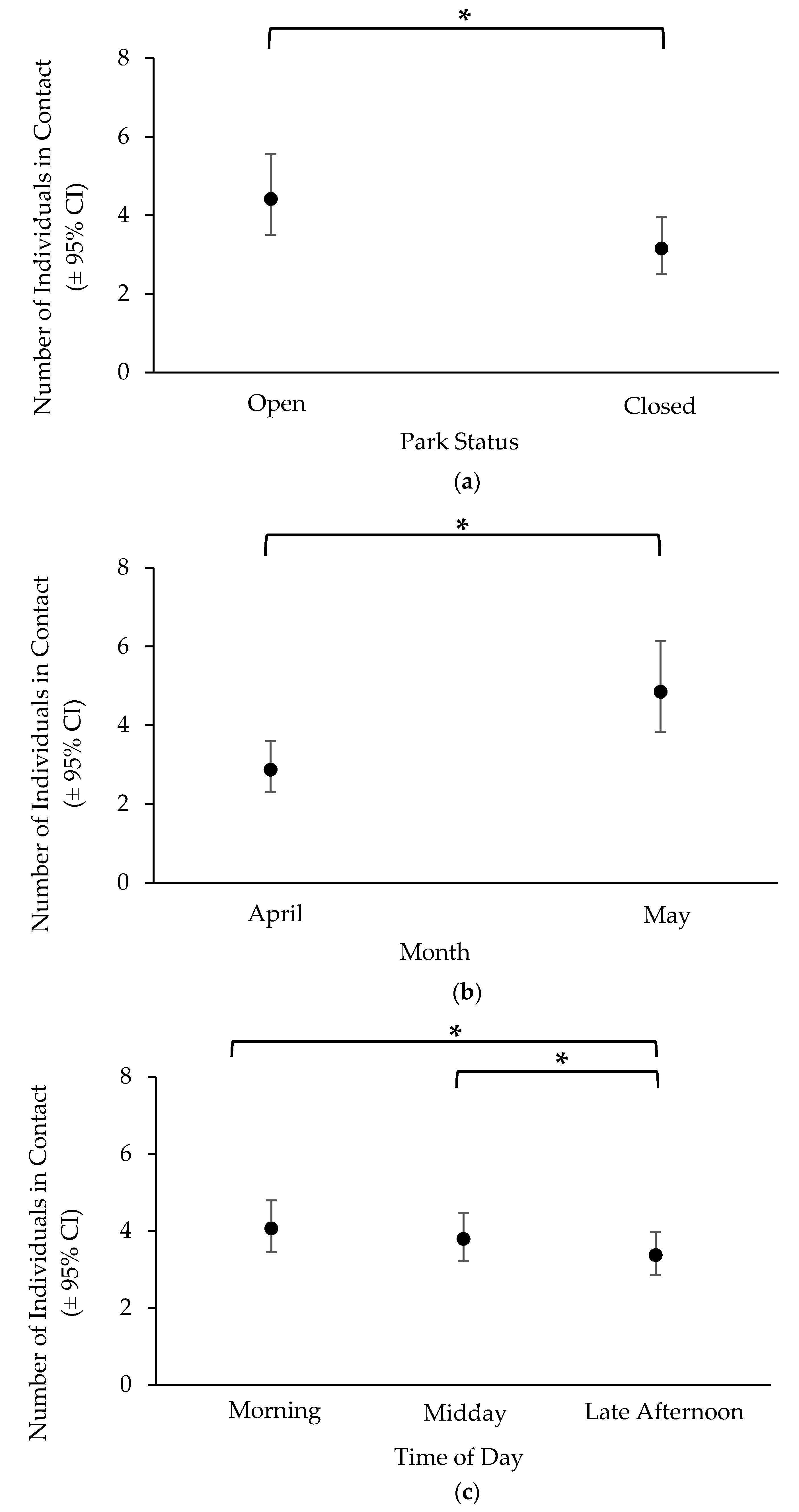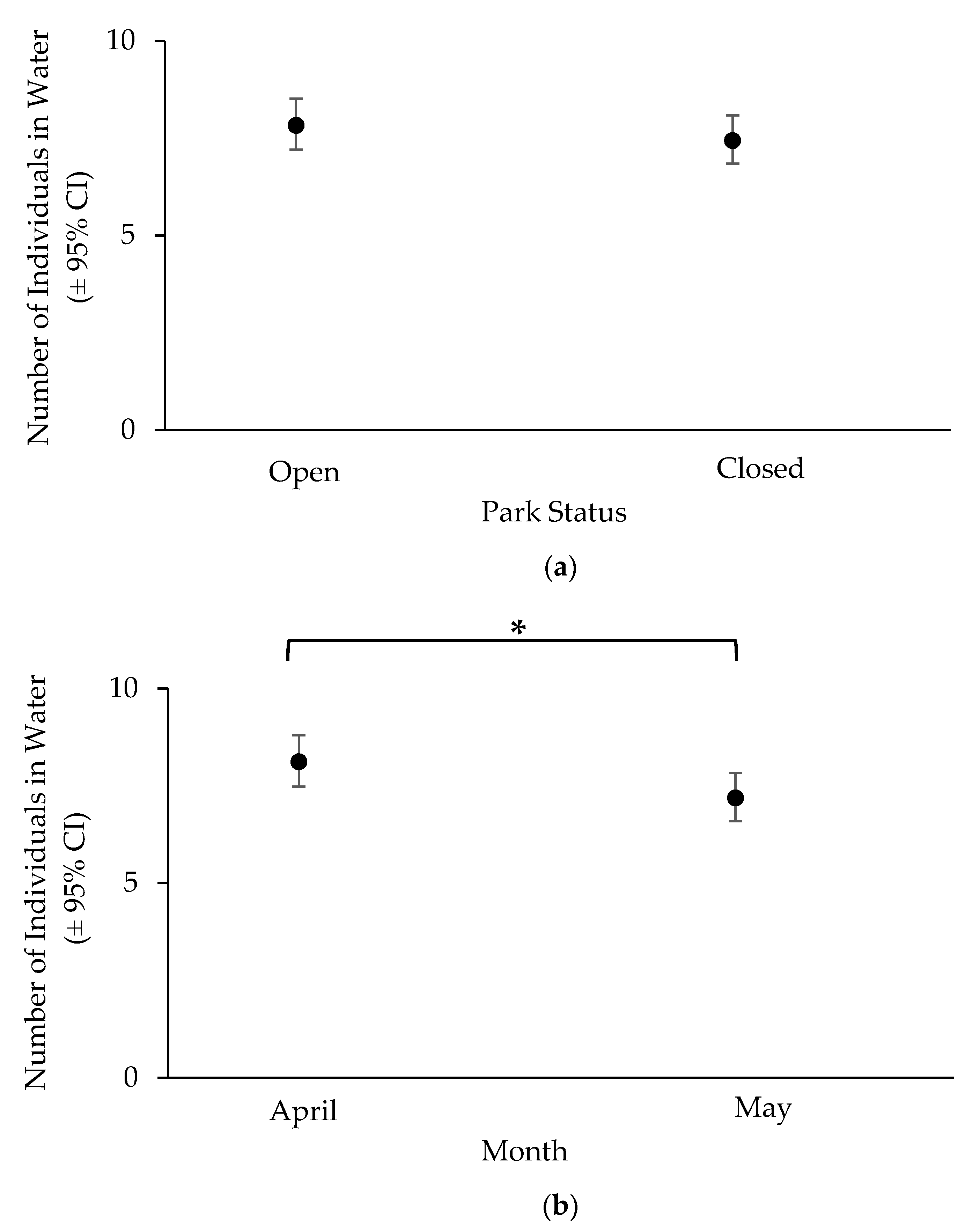Evaluating the Effect of Visitor Presence on Nile Crocodile (Crocodylus niloticus) Behavior
Abstract
1. Introduction
2. Materials and Methods
3. Results
3.1. Social Behavior
3.2. Social Proximity
3.3. Space Use
4. Discussion
Author Contributions
Funding
Institutional Review Board Statement
Data Availability Statement
Acknowledgments
Conflicts of Interest
References
- Bonnie, K.E.; Ang, M.Y.L.; Ross, S.R. Effects of crowd size on exhibit use by and behaviour of chimpanzees (Pan troglodytes) and western lowland gorillas (Gorilla gorilla) at a zoo. Appl. Anim. Behav. Sci. 2016, 178, 102–110. [Google Scholar] [CrossRef]
- Hosey, G.R. Zoo animals and their human audiences: What is the visitor effect? Anim. Welf. 2000, 9, 343–357. [Google Scholar]
- Sherwen, S.L.; Hemsworth, P.H. The visitor effect on zoo animals: Implications and opportunities for zoo animal welfare. Animals 2019, 9, 366. [Google Scholar] [CrossRef] [PubMed]
- Sekar, M.; Rajagopal, T.; Archunan, G. Influence of Zoo Visitor Presence on the Behavior of Captive Indian Gaur (Bos gaurus gaurus) in a Zoological Park. J. Appl. Anim. Welf. Sci. 2008, 11, 352–357. [Google Scholar] [CrossRef] [PubMed]
- Wells, D. A note on the influence of visitors on the behavior and welfare of zoo-housed gorillas. App. Anim. Behav. Sci. 2008, 93, 13–17. [Google Scholar] [CrossRef]
- Farrand, A.; Hosey, G.; Buchanan-Smith, H.M. The visitor effect in petting zoo-housed animals: Aversive or enriching? Appl. Anim. Behav. Sci. 2014, 151, 117–127. [Google Scholar] [CrossRef]
- Chiew, S.J.; Butler, K.L.; Sherwen, S.L.; Coleman, G.J.; Fanson, K.V.; Hemsorth, P.H. Effects of regulating visitor viewing proximity and the intensity of visitor behaviour on the little penguin (Eudyptula minor) behaviour and welfare. Animals 2019, 9, 285. [Google Scholar] [CrossRef] [PubMed]
- Bortolini, T.S.; Bicca-Marques, J.C. The effect of environmental enrichment and visitors on the behaviour and welfare of two captive hamadryas baboons (Papio hamadryas). Anim. Welf. 2011, 20, 573. [Google Scholar]
- Sellinger, R.L.; Ha, J.C. The effects of visitor density and intensity on the behaviour of two captive jaguars (Panthera onca). J. Appl. Anim. Welf. Sci. 2005, 8, 233–244. [Google Scholar] [CrossRef] [PubMed]
- Sherwen, S.L.; Magrath, M.J.; Butler, K.L.; Phillips, C.J.; Hemsworth, P.H. A multi-enclosure study investigating the behavioural response of meerkats to zoo visitors. Appl. Anim. Behav. Sci. 2014, 156, 70–77. [Google Scholar] [CrossRef]
- O’Donovan, D.E.; Hindle, J.E.; McKeown, S.; O’Donovan, S. Effect of visitors on the behaviour of female cheetahs, Acinonyx jubatus and cubs. Int. Zoo Yearb. 1993, 32, 238–244. [Google Scholar] [CrossRef]
- Margulis, S.W.; Hoyos, C.; Anderson, M. Effect of felid activity on zoo visitor interest. Zoo Biol. 2003, 22, 587–599. [Google Scholar] [CrossRef]
- Normando, S.; Pollastri, I.; Florio, D.; Ferrante, L.; Macchi, E.; Isaja, V.; de Mori, B. Assessing Animal Welfare in Animal-Visitor Interactions in Zoos and Other Facilities. A Pilot Study Involving Giraffes. Animals 2018, 8, 153. [Google Scholar] [CrossRef] [PubMed]
- Todd, P.A.; Macdonald, C.; Coleman, D. Visitor-associated variation in captive Diana monkey (Cercopithecus diana diana) behaviour. Appl. Anim. Behav. Sci. 2007, 107, 162–165. [Google Scholar] [CrossRef]
- Bloomfield, R.C.; Gillespie, G.R.; Kerswell, K.J.; Butler, K.L.; Hemsworth, P.H. Effect of partial covering of the visitor viewing area window on positioning and orientation of zoo orangutans: A preference test. Zoo Biol. 2015, 34, 223–229. [Google Scholar] [CrossRef] [PubMed]
- Nimon, A.; Dalziel, F. Cross-species interaction and communication: A study method applied to captive siamang (Hylobates syndactylus) and long-billed corella (Cacatua tenuirostris) contacts with humans. Appl. Anim. Behav. Sci. 1992, 33, 261–272. [Google Scholar] [CrossRef]
- Eltorai, A.E.; Sussman, R.W. The “Visitor Effect” and captive black-tailed prairie dog behavior. Der Zoologische Garten 2010, 79, 109–120. [Google Scholar] [CrossRef]
- Collins, C.K.; Quirke, T.; Overy, L.; Flannery, K.; O’Riordan, R. The effect of the zoo setting on the behavioural diversity of captive gentoo penguins and the implications for their educational potential. J. Zoo Aquar. Res. 2016, 4, 85–90. [Google Scholar]
- Goodenough, A.E. Are “visitor effects” overestimated? Behaviour in captive lemurs is mainly driven by co-variation with time and weather. J. Zoo Aquar. Res. 2019, 7, 59–66. [Google Scholar]
- Collins, C.; Corkery, I.; Haigh, A.; McKeown, S.; Quirke, T.; O’Riordan, R. The effects of environmental and visitor variables on the behavior of free-ranging ring-tailed lemurs (Lemur catta) in captivity. Zoo Biol. 2017, 36, 250–260. [Google Scholar] [CrossRef]
- Ballantyne, R.; Packer, J.; Hughes, K.; Dierking, L. Conservation learning in wildlife tourism settings: Lessons from research in zoos and aquariums. Envir. Edu. Res. 2007, 13, 367–383. [Google Scholar] [CrossRef]
- Mason, P. Zoo tourism: The need for more research. J. Sust. Tourism. 2000, 8, 333–339. [Google Scholar] [CrossRef]
- Glatston, A.R.; van Hoo, J.A.R.A.M.; Geilvoet-Soeteman, E.; Hora-Pecek, E.; Geilvoet-Soeteman, E.; Hora-Pecek, E. The influence of the zoo environment on social behavior of groups of cotton-topped tamarins, Saguinus oedipus oedipus. Zoo Biol. 1984, 3, 241–253. [Google Scholar] [CrossRef]
- Mitchell, G.; Herring, F.; Obradovich, S.; Tromborg, C.; Dowd, B.; Neville, L.E.; Field, L. Effects of visitors and cage changes on the behaviors of mangabeys. Zoo Biol. 1991, 10, 417–423. [Google Scholar] [CrossRef]
- Mitchell, G.; Tromborg, C.T.; Kaufman, J.; Bargabus, S.; Simoni, R.; Geissler, V. More on the influence of zoo visitors on the behavior of captive primates. Appl. Anim. Behav. Sci. 1992, 35, 189–198. [Google Scholar] [CrossRef]
- Williams, E.; Carter, A.; Rendle, J.; Ward, S.J. Understanding impacts of zoo visitors: Quatifying behavioural changes of two popular zoo species during COVID-19 closures. Appl. Anim. Behav. Sci. 2021, 236, 1–8. [Google Scholar] [CrossRef]
- Hosey, G.; Melfi, V.; Ward, S.J. Problematic Wildlife II; Springer Nature Switzerland AG: Cham, Switzerland, 2020; pp. 485–508. [Google Scholar]
- Binding, S.; Farmer, H.; Krusin, L.; Cronin, K. Status of animal welfare research in zoos and aquariums: Where are we, where to next? J. Zoo Aquar. Res. 2020, 8, 166–174. [Google Scholar]
- Freeland, L.; Ellis, C.; Michaels, C.J. Documenting aggression, dominance and the impacts of visitor interaction on Galápagos tortoises (Chelonoidis nigra) in a zoo setting. Animals 2020, 10, 699. [Google Scholar] [CrossRef]
- Chamove, A.S.; Hosey, G.; Schaetzel, P. Visitors excite primates in zoos. Zoo Biol. 1988, 7, 359–369. [Google Scholar] [CrossRef]
- Sherwen, S.L.; Harvey, T.J.; Magrath, M.J.; Butler, K.L.; Fanson, K.V.; Hemsworth, P.H. Effects of visual contact with zoo visitors on black-capped capuchin welfare. Appl. Anim. Behav. Sci. 2015, 167, 65–73. [Google Scholar] [CrossRef]
- Seebacher, F.; Grigg, G.C.; Beard, L.A. Crocodiles as dinosaurs: Behavioural thermoregulation in very large ectotherms leads to high and stable body temperatures. J. Exp. Biol. 1999, 202, 77–86. [Google Scholar] [PubMed]
- Pough, F.H. Amphibians and reptiles as low-energy systems. In Behavioural Energetics: The Cost of Survival in Vertebrates; Aspey, W.P., Lustick, S., Eds.; Ohio State University Press: Columbus, OH, USA, 1983; pp. 141–188. [Google Scholar]
- Carr, C.E.; Christensen-Dalsgaard, J.; Bierman, H. Coupled ears in lizards and crocodilians. Biol. Cybernetics. 2016, 110, 291–302. [Google Scholar] [CrossRef]
- Higgs, D.; Brittan-Powel, E.; Soares, D.; Souza, M.; Carr, C.; Dooling, R.; Popper, A. Amphibious auditory responses of the American alligator (Alligator mississipiensis). J. Comp. Physiol. 2002, 188, 217–223. [Google Scholar]
- Vergne, A.L.; Pritz, M.B.; Mathevon, N. Acoustic communication in crocodilians: From behaviour to brain. Biol. Rev. 2009, 84, 391–411. [Google Scholar] [CrossRef] [PubMed]
- Wever, E.G. Sound transmission in the salamander ear. Proc. Natl. Acad. Sci. USA 1978, 75, 529–530. [Google Scholar] [CrossRef] [PubMed]
- Garrick, L.D.; Lang, J.W. Social signals and behaviors of adult alligators and crocodiles. Amer. Zool. 1977, 17, 225–239. [Google Scholar] [CrossRef]
- Nagloo, N.; Collin, S.P.; Hemmi, J.M.; Hart, N.S. Spatial resolving power and spectral sensitivity of the saltwater crocodile, Crocodylus porosus, and the freshwater crocodile, Crocodylus johnstoni. J. Exp. Biol. 2016, 219, 1394–1404. [Google Scholar] [CrossRef] [PubMed]
- Brien, M.L.; Lang, J.W.; Webb, G.J.; Stevenson, C.; Christian, K.A. The good, the bad, and the ugly: Agonistic behaviour in juvenile crocodilians. PLoS ONE. 2013, 8, 1–12. [Google Scholar] [CrossRef] [PubMed]
- Bolker, B.M.; Brooks, M.E.; Clark, C.J.; Geange, S.Q.; Poulsen, J.R.; Stevens, M.H.H.; White, J.S.S. Generalized linear mixed models: A practical guide for ecology and evolution. Trends Ecol. Evol. 2009, 24, 127–135. [Google Scholar] [CrossRef]
- Zuur, A.F.; Ieno, E.N.; Elphick, C.S. A protocol for conducting and presenting results of regression-type analyses. Methods Ecol. Evol. 2010, 7, 636–645. [Google Scholar] [CrossRef]
- Quinn, G.P.; Keough, M.J. Experimental Design and Data Analysis for Biologists; Cambridge University Press: Cambridge, UK, 2002. [Google Scholar]
- Mundry, R. Issues in information theory-based statistical inference—A commentary from a frequentist’s perspective. Behav. Ecol. Sociobio. 2011, 65, 57–68. [Google Scholar] [CrossRef]
- Mundry, R.; Nunn, C.L. Stepwise model fitting and statistical inference: Turning noise into signal pollution. Am. Nat. 2009, 173, 119–123. [Google Scholar] [CrossRef] [PubMed]
- Wood, W. Interactions among environmental enrichment, viewing crowds, and zoo chimpanzees (Pan troglodytes). Zoo Biol. 1998, 17, 211–230. [Google Scholar] [CrossRef]
- Dufour, V.; Sueur, C.; Whiten, A.; Buchanan-Smith, H.M. The impact of moving to a novel environment on social networks, activity and wellbeing in two new world primates. Am. J. Primatol. 2011, 73, 802–811. [Google Scholar] [CrossRef] [PubMed]
- Stagni, E.; Normando, S.; de Mori, B. Distances between individuals in an artificial herd of African elephants (Loxodonta africana africana) during resource utilisation in a semi-captive environment. Res. Vet. Sci. 2017, 113, 122–129. [Google Scholar] [CrossRef]
- Kleinhappel, T.K.; Pike, T.W.; Burman, O.H.P. Stress-induced changes in group behaviour. Sci. Rep. 2019, 9, 1–9. [Google Scholar]
- Hamilton, W.D. Geometry for the selfish herd. J. Theor. Biol. 1971, 31, 295–311. [Google Scholar] [CrossRef]
- Treves, A. Theory and method in studies of vigilance and aggregation. Anim. Behav. 2000, 60, 711–722. [Google Scholar] [CrossRef] [PubMed]
- Ganswindt, S. Non-Invasive Assessment of Adrenocortical Function in Captive Nile Crocodiles (Crocodylus niloticus) and its Relation to Housing Conditions. Master’s Thesis, University of Pretoria, Pretoria, South Africa, 2012. [Google Scholar]
- Veldsman, D.M. Effects of stocking density on production and behaviour of farmed grower Nile crocodiles (Crocodylus niloticus). Master’s Thesis, University of Pretoria, Pretoria, South Africa, 2019. [Google Scholar]
- De Vere, A.J. Visitor effects on a zoo population of California sea lions (Zalophus californianus) and harbor seals (Phoca vitulina). Zoo Biol. 2018, 37, 162–170. [Google Scholar] [CrossRef] [PubMed]
- Choo, Y.; Todd, P.A.; Li, D. Visitor effects on zoo orangutans in two novel, naturalistic enclosures. Appl. Anim. Behav. Sci. 2011, 133, 78–86. [Google Scholar] [CrossRef]
- Downs, C.T.; Greaver, C.; Taylor, R. Body temperature and basking behavior of Nile crocodiles (Crocodylus niloticus) during winter. J. Therm. Biol. 2008, 33, 185–192. [Google Scholar] [CrossRef]
- Srivastava, A.; Borries, C.; Sommer, V. Homosexual mounting in free-ranging female Hanuman langurs (Presbytis entellus). Arch. Sex. Behav. 1991, 20, 487–512. [Google Scholar] [CrossRef] [PubMed]
- Cordischi, C.; Cozzolino, R.; Aureli, F.; Scucchi, S. Influence of context on mounting and presenting among mature male Japanese macaques. Folia Primatologica. 1991, 56, 211–213. [Google Scholar] [CrossRef] [PubMed]
- Maréchal, L.; Maclarnon, A.; Majolo, B.; Semple, S. Primates’ behavioural responses to tourists: Evidence for a trade-off between potential risks and benefits. Sci. Rep. 2016, 6, 1–11. [Google Scholar] [CrossRef] [PubMed]
- du Preez, M.; Govender, D.; Kylin, H.; Bouwman, H. Metallic elements in Nile Crocodile eggs from the Kruger National Park, South Africa. Ecotoxicol. Envir. Safety 2018, 148, 930–941. [Google Scholar] [CrossRef]
- Behangana, M.; Magala, R.; Katumba, R.; Ochanda, D.; Kigoolo, S.; Mutebi, S.; Dendi, D.; Luiselli, L.; Hughes, D.F. Ontogenetic habitat use and seasonal activity of Nile crocodiles (Crocodylus niloticus) in the Lake Albert delta, East Africa. J. Great Lakes Res. 2020, 46, 1776–1782. [Google Scholar] [CrossRef]
- Kofron, C.P. The reproductive cycle of the Nile crocodile (Crocodylus niloticus). J. Zool. London. 1990, 221, 477–488. [Google Scholar] [CrossRef]
- Seebacher, F.; Shine, R. Evaluating thermoregulation in reptiles: The fallacy of the inappropriately applied method. Physiol. Biochem. Zool. 2004, 77, 688–695. [Google Scholar] [CrossRef] [PubMed]
- Spain, M.S.; Fuller, G.; Allard, S.M. Effects of habitat modifications on behavioral indicators of welfare for Madagascar giant hognose snakes (Leioheterodon madagascariensis). Anim. Behav. Cogn. 2020, 7, 70–81. [Google Scholar] [CrossRef]
- Bashaw, M.J.; Gibson, M.D.; Schowe, D.M.; Kucher, A.S. Does enrichment improve reptile welfare? Leopard geckos (Eublepharis macularius) respond to five types of environmental enrichment. Appl. Anim. Behav. Sci. 2016, 184, 150–160. [Google Scholar] [CrossRef]
- Benn, A.L.; McLelland, D.J.; Whittaker, A.L. A review of welfare assessment methods in reptiles, and preliminary application of the welfare quality® protocol to the pygmy blue-tongue skink, Tiliqua adelaidensis, using animal-based measures. Animals 2019, 9, 27. [Google Scholar] [CrossRef] [PubMed]
- Leeds, A.; Stone, D.; Johnson, B.; Less, E.; Schoffner, T.; Dennis, P.; Lukas, K.; Wark, J. Managing repetitive locomotor behaviour and time spent off exhibit in a male black-footed cat (Felis nigripes) through exhibit and husbandry modifications. J. Zoo Aquar. Res. 2016, 4, 109–114. [Google Scholar]
- Ross, S.R.; Schapiro, S.J.; Hau, J.; Lukas, K.E. Space use as an indicator of enclosure appropriateness: A novel measure of captive animal welfare. Appl. Anim. Behav. Sci. 2009, 121, 42–50. [Google Scholar] [CrossRef]





| Behavior | Definition | Collection Method |
|---|---|---|
| Agonistic Behavior | Aggressive or intolerant behaviors directed from one crocodile towards a conspecific resulting in physical contact [40] including bite and jaw clash. A bite was defined as one crocodile closing one’s jaws around a conspecific, possibly including a roll or shake. Jaw clash was defined as two crocodiles striking heads together with their mouths open. | All-occurrence sampling |
| Sociosexual Behavior | The occurrence of mounting, defined as one crocodile attempting to or successfully climbing onto a conspecific dorsal-ventrally. Mounting may include the initiator curling their tail underneath the receiver and grasping the receiver’s body with their feet. | All-occurrence sampling |
| Conspecific Bunting Behavior | One crocodile rubbing or pushing their head or body against the head or body of a conspecific for at least three seconds. | All-occurrence sampling |
| In Contact | The count of crocodiles in physical contact (touching) with a conspecific. | Scan sampling |
| Space Use | The count of crocodiles in the water of their exhibit. If a crocodile had part of their body both in water and on land they were counted as in water if the majority (>50%) of their body was in water. | Scan sampling |
| Variable | Number of Observations | Mean Temperatures (°F) |
|---|---|---|
| All Observations | 158 | 80.4 (SE = 0.60) |
| Park Open | 79 | 80.5 (SE = 0.82) |
| Park Closed | 79 | 80.3 (SE = 0.88) |
| April | 82 | 77.7 (SE = 0.86) |
| May | 76 | 83.3 (SE = 0.69) |
| April 2019 | 41 | 76.9 (SE = 1.22) |
| May 2019 | 38 | 83.9 (SE = 0.96) |
| April 2020 | 41 | 78.4 (SE = 1.21) |
| May 2020 | 38 | 82.7 (SE = 1.02) |
| Morning | 58 | 74.7 (SE = 0.88) |
| Midday | 56 | 83.9 (SE = 0.66) |
| Afternoon | 44 | 83.4 (SE = 1.04) |
Publisher’s Note: MDPI stays neutral with regard to jurisdictional claims in published maps and institutional affiliations. |
© 2021 by the authors. Licensee MDPI, Basel, Switzerland. This article is an open access article distributed under the terms and conditions of the Creative Commons Attribution (CC BY) license (http://creativecommons.org/licenses/by/4.0/).
Share and Cite
Riley, A.; Terry, M.; Freeman, H.; Alba, A.C.; Soltis, J.; Leeds, A. Evaluating the Effect of Visitor Presence on Nile Crocodile (Crocodylus niloticus) Behavior. J. Zool. Bot. Gard. 2021, 2, 115-129. https://doi.org/10.3390/jzbg2010009
Riley A, Terry M, Freeman H, Alba AC, Soltis J, Leeds A. Evaluating the Effect of Visitor Presence on Nile Crocodile (Crocodylus niloticus) Behavior. Journal of Zoological and Botanical Gardens. 2021; 2(1):115-129. https://doi.org/10.3390/jzbg2010009
Chicago/Turabian StyleRiley, Alex, Megan Terry, Hani Freeman, Andrew C. Alba, Joseph Soltis, and Austin Leeds. 2021. "Evaluating the Effect of Visitor Presence on Nile Crocodile (Crocodylus niloticus) Behavior" Journal of Zoological and Botanical Gardens 2, no. 1: 115-129. https://doi.org/10.3390/jzbg2010009
APA StyleRiley, A., Terry, M., Freeman, H., Alba, A. C., Soltis, J., & Leeds, A. (2021). Evaluating the Effect of Visitor Presence on Nile Crocodile (Crocodylus niloticus) Behavior. Journal of Zoological and Botanical Gardens, 2(1), 115-129. https://doi.org/10.3390/jzbg2010009






